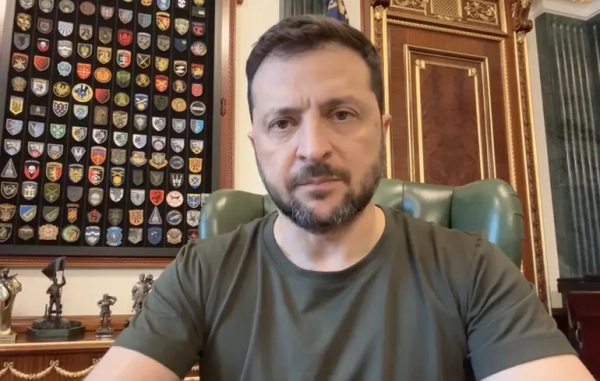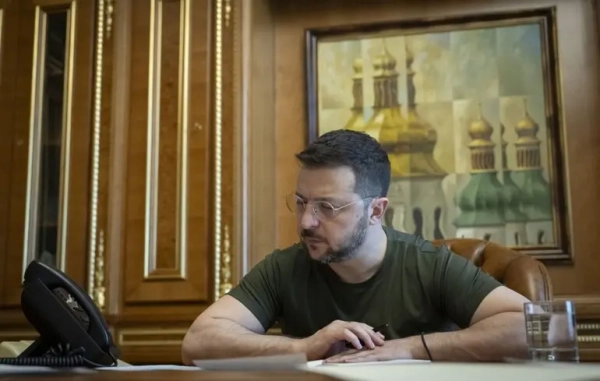Was her death an unusual tragedy — or a policy failure?

Supporters of former US President and 2024 presidential hopeful Donald Trump hold images of Laken Riley before he speaks at a “Get Out the Vote” rally in Rome, Georgia, on March 9, 2024. Riley, a nursing student, has become the face of immigration reform after her murder allegedly by an illegal immigrant on February 22, 2024. Elijah Nouvelage/AFP via Getty Andrew Prokop is a senior politics correspondent at Vox, covering the White House, elections, and political scandals and investigations. He’s worked at Vox since the site’s launch in 2014, and before that, he worked as a research assistant at the New Yorker’s Washington, DC, bureau.
On the evening of February 23, reports spread that the suspect in the killing of Laken Riley, a 22-year-old nursing student who was murdered while out jogging on the University of Georgia campus, had entered the US illegally.
That night, the conservative writer Ryan James Gidursky wrote in a viral post on X, “If only people went to the streets to demand change in the name of Laken Riley, like they did for George Floyd.”
Now, the Trump campaign is trying to make Riley the face of its argument that Joe Biden’s border policies have deadly consequences. During the State of the Union address, Rep. Marjorie Taylor Greene (R-GA) triggered an unscripted moment from Biden, in which he tried to address Riley’s death. Before a Georgia rally on March 9, Trump met some of Riley’s family members, while his campaign team handed out pictures of Riley to the crowd. And this past weekend, Trump mentioned Riley repeatedly at another rally in Ohio.
Trump has demagogued unauthorized immigrants as dangerous criminals since his first campaign for president, and this year he’s returning to that familiar theme, accusing immigrants of “poisoning the blood” of the country.
But while he has hosted rallies before that featured family members of people killed by unauthorized immigrants, Riley’s death seems set up to be more central to his campaign messaging than any of these prior tragedies.
Trump evidently thinks he can lay it directly at his opponent’s feet, blaming Biden’s failure to control the border (and changing the subject from Trump’s own role in scuttling Biden’s bipartisan border security bill). He’s also trying to argue that Riley’s death isn’t an isolated tragedy, but part of a larger trend of “migrant crime” — once again smearing a vast and diverse group of people as criminals.
And now, activists and commentators on the right are blatantly trying to mirror the rhetoric and tactics used by activists against police violence. “Say her name!” Greene and others on the right have said — the demand activists on the left made about Black women who were victims of police violence, such as Breonna Taylor.
Democrats have a tricky task in responding. They don’t want to be seen as dismissing or excusing any individual tragedy, but they also don’t want to give in to demagoguery and xenophobia against immigrants — the vast, vast majority of whom are not violent criminals and who simply are seeking better lives for themselves and their families.
The tightrope they’re walking was evident after the State of the Union, during which Biden described Riley’s accused killer, Jose Antonio Ibarra, as “an illegal” — repeating Greene’s phrasing. Many Latinos view that as an offensive term, and Biden later said he regretted using it.
The awkward reality is that Biden is, indeed, vulnerable to critique that he has mishandled border policy. But Trump is characteristically spreading nonsense, falsehoods, and hate, using this tragedy for political gain and hoping it will propel him back into the White House.
How Laken Riley’s accused killer made it into the US
On September 8, 2022, about 17 months before Laken Riley was killed, Jose Antonio Ibarra was arrested in El Paso, Texas, with his girlfriend and her 5-year-old son for crossing the border illegally. (Their home country is Venezuela.) The family was soon released into the United States.
Their release shouldn’t be a surprise — many migrants whom officials encounter at the border are released into the US after processing.
That happens for several reasons. The US government has limited detention capacity and deportation resources. A huge number of migrants keep arriving and overwhelming those resources. And there’s a legal process that allows migrants seeking asylum to contest their removal and stay in the US while their cases are adjudicated.
There’s another reason particular to migrants coming from countries with which the US has hostile relations, like Venezuela. In September 2022, the Venezuelan government was refusing to accept deportees sent by the US — and Mexico wasn’t accepting them either.
With deportation not an option for Ibarra, the only alternative to releasing him would have been indefinite detention. But again, there’s limited detention capacity — at that point, ICE had about 26,000 people detained, but more than 1 million arriving migrants had been released to the US that year while their cases played out.
The Department of Homeland Security has not publicly commented on Ibarra’s case or the decision to release him. According to the New York Post, ICE records state Ibarra was released due to lack of detention capacity.
After his release, Ibarra settled with his family in New York, married his girlfriend, and worked for food delivery services and a restaurant before having two brushes with the law.
The first was last August, when Ibarra was doing food deliveries in New York on a moped — while riding with his young stepson, who had no helmet or restraints. He was arrested then for endangering the welfare of a child, but the case was sealed and he was released.
The second was last October in Athens, Georgia, where Ibarra had moved to live with his brother — he and his brother were issued citations after being accused of shoplifting from a Walmart.
Neither of these incidents in and of themselves show violent, and certainly not murderous, behavior. That is, however, what authorities argue Ibarra did to Riley in February, with police saying surveillance camera footage links him to the crime. (A neighbor has claimed that a surveillance camera recorded Ibarra disposing of bloody clothes.)
Was Riley’s murder an unusual, isolated tragedy — or a policy failure?
The Trump campaign’s attempt to make this a broader critique of Biden’s border policies relies on two main arguments — both misleading.
First, the argument that unauthorized immigrants commit more violent crime: Trump’s false claim, repeated endlessly since his first presidential campaign announcement speech in June 2015, has been that unauthorized immigrants are highly likely to be dangerous and violent criminals. Critics often respond to this by pointing to studies showing that immigrants in general (including legal immigrants) commit crimes at rates far lower than native-born Americans.
Ascertaining crime rates for unauthorized immigrants specifically is tougher, because state and local governments typically don’t collect or keep that data in a systemized way. But the state of Texas does, so Alex Nowrasteh of the Cato Institute looked into the numbers there.
Nowrasteh found that, in 2015, 43 unauthorized immigrants were arrested who were later convicted of homicide in Texas. That amounts to a rate of 2.4 per 100,000 in the population — a slightly lower homicide conviction rate than native-born Americans in the state, who were convicted at a rate of 2.8 per 100,000. (A conservative think tank has disputed the numbers, saying there were somewhat more convicted killers, but Nowrasteh argues they are double-counting some of them.)
So, contra Trump’s portrayals, unauthorized immigrants don’t appear to be more likely to be violent criminals. “Few people are murderers, and illegal immigrants are statistically less likely to be murderers,” Nowrasteh writes.
The second argument is that this is a predictable result of Biden’s border policy: Trump’s other claim is that Biden specifically has botched the handling of immigration and border policy — and that Riley’s death is just one example of this.
Biden has acknowledged that the situation at the border is “broken.” But he argues that this failure isn’t his fault, saying he lacks the resources and legal authority to get things under control. That’s why, he says, he negotiated a bipartisan border bill, which passed the Senate — but the House killed it at Trump’s behest for political reasons.
The reality is more complicated. The Biden administration has long been torn between progressives’ impulse to help more immigrants and moderates’ concerns about practical and political problems posed by millions of new migrants arriving per year.
Various policies they’ve rolled out in hope of deterring new arrivals have not succeeded. The fact that the president waited until late 2023, when Ukraine aid suddenly seemed at risk, to seriously negotiate with Republicans on a border bill also may call into question his urgency in addressing the topic.
But reality is also more complicated than Trump’s promises that he’ll fix everything by getting tougher once he’s president.
Trump, recall, was president before, and he did not end illegal immigration — in fact, the number of migrants arriving at the southern border soared in 2019, his third year in office (though the pandemic drove the numbers back down the following year).
He would adopt more aggressive policies than Biden, but he would face the same challenges, such as limited detention and deportation resources, lengthy asylum adjudication processes, and an inability to send people back to hostile countries.
Trump will certainly try to dramatically ramp up detention and enforcement in hopes of deterring new arrivals. But conditions are so miserable in many of these migrants’ home countries that, for many, it will likely still be worth it to roll the dice and try to get to the US.
Trump is exploiting the issue for political benefit
When news of Riley’s death first broke, but before law enforcement officials had identified the suspect, one viral post on X adopted a different frame.
“My mind finds it incomprehensible that in 2024 women STILL cannot go for a run without the possibility of being murdered,” wrote Simone De Alba, a news anchor for WUSA9. “Laken Riley was 22 years old, a nursing student at Augusta University. She was murdered on UGA’s campus. Running, folks. That’s it. She was on a damn run.”
Soon afterward, the interpretation of Riley’s death as a chilling example of violence against women was swept aside by the right’s focus on the suspect’s immigration status. Conservatives argued that the only relevant fact was that the suspect “shouldn’t be” in the US.
But why must that be the only relevant fact? This was a statistically unusual crime in many respects. Murders of young white women by strangers are not common, hence the media attention that often accompanies them.
And the claim that such a terrible act is typical of unauthorized immigrants is a noxious lie — one that just fans the flames of hate to try to help a presidential candidate win.
Sourse: vox.com






